|
 WETTABILITY
WETTABILITY
Wettability is the
tendency of one fluid to spread on, or adhere to, a solid
surface in the presence of other immiscible fluids.
Wettability refers to the interaction between fluid and
solid phases. In a reservoir rock the liquid phase can be
water or oil or gas, and the solid phase is the rock mineral
assemblage.
Wettability is defined by
the contact angle of the fluid with the solid phase.
Interfacial (boundary) tension (SIGMA) is the energy per
unit area (force per unit distance) at the surface between
phases. It is commonly expressed in milli-Newtons/meter
(also, dynes/cm).
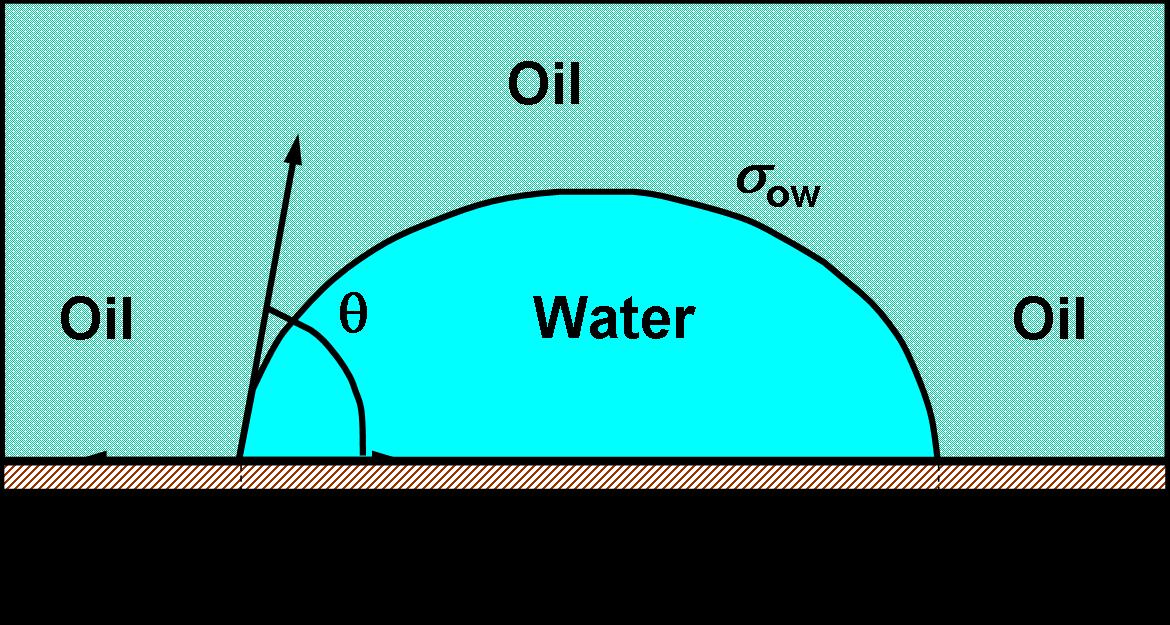
Adhesion
tension (AT) is expressed as the difference between
two solid-fluid interfacial tensions. A negative
adhesion tension indicates that the denser phase
(water) preferentially wets the solid surface (and
vice versa).
•An adhesion tension of 0.0 indicates
that both phases have equal affinity for the solid
surface.
When 2 or more
fluids are present, there are at least 3 sets of
forces acting on the fluids and affecting
hydrocarbon recovery.
 DEFINITIONS
DEFINITIONS
AT =
adhesion tension
THETA = contact angle
between the
oil/water/solid
interface measured
through the water
SIGMAos
=
interfacial energy
between the oil and
solid
SIGMAws =
interfacial energy
between the water and
solid
SIGMAow
=
interfacial energy
(interfacial tension)
between the oil and
water
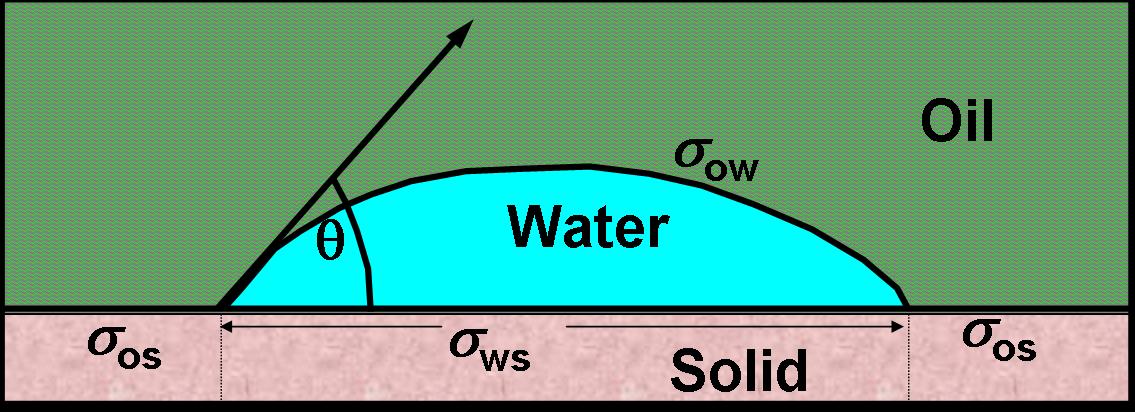 Wetting
phase fluid preferentially wets
the solid rock surface. Attractive
forces between rock and fluid
draw the wetting phase into
small pores. Wetting phase fluid
often has low mobility. Wetting
phase fluid preferentially wets
the solid rock surface. Attractive
forces between rock and fluid
draw the wetting phase into
small pores. Wetting phase fluid
often has low mobility.
Attractive forces determine the
lower limit to irreducible
wetting phase saturation. Many
hydrocarbon reservoirs are
either totally or partially
water-wet.
Reservoir
rock is
water
wet
if water preferentially
wets the rock surfaces.
The rock
is water wet under the
following conditions:
SIGMAws >=
SIGMAos
AT
< 0
(i.e., the adhesion
tension is negative)
•
0°
<= THETA <=
90°
When THETA is close
to 0°,
the rock is considered
to be “strongly
water wet”.
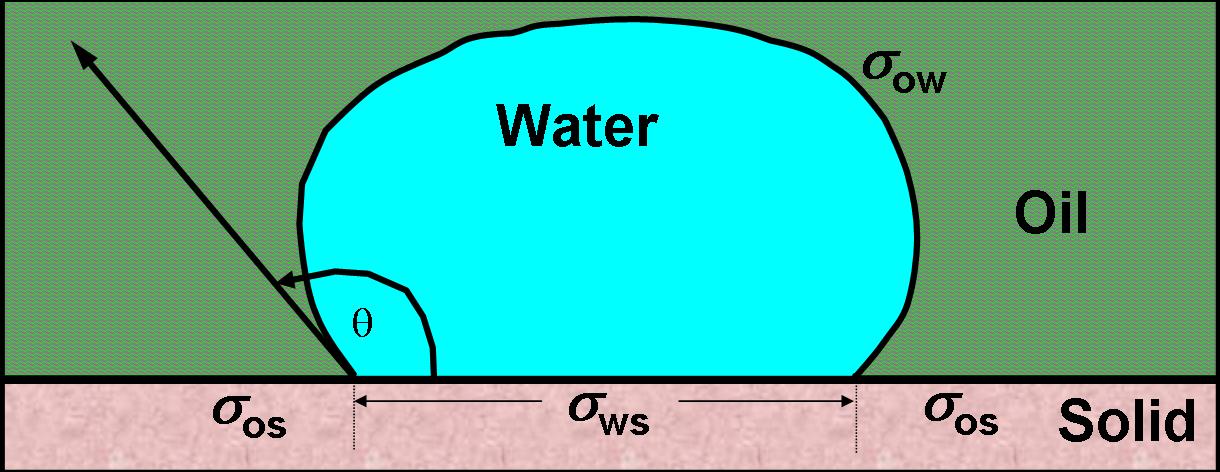 Nonwetting
phase does not preferentially
wet the solid rock surface.
Repulsive forces between rock
and fluid cause nonwetting phase
to occupy largest pores.
Nonwetting phase fluid is often
the most mobile fluid,
especially at large nonwetting
phase saturations. Natural gas is
never the wetting phase in
hydrocarbon reservoirs. Nonwetting
phase does not preferentially
wet the solid rock surface.
Repulsive forces between rock
and fluid cause nonwetting phase
to occupy largest pores.
Nonwetting phase fluid is often
the most mobile fluid,
especially at large nonwetting
phase saturations. Natural gas is
never the wetting phase in
hydrocarbon reservoirs.
•
Reservoir rock is oil-wet if oil
preferentially wets the rock
surfaces.
•The
rock is oil wet under the
following conditions:
•
SIGMAos >=
SIGMAws
A
T >
0 (i.e., the adhesion tension is
positive)
90°
<= THETA <=
180°
When THETA is close to 180°,
the rock is considered to be
“strongly oil wet”
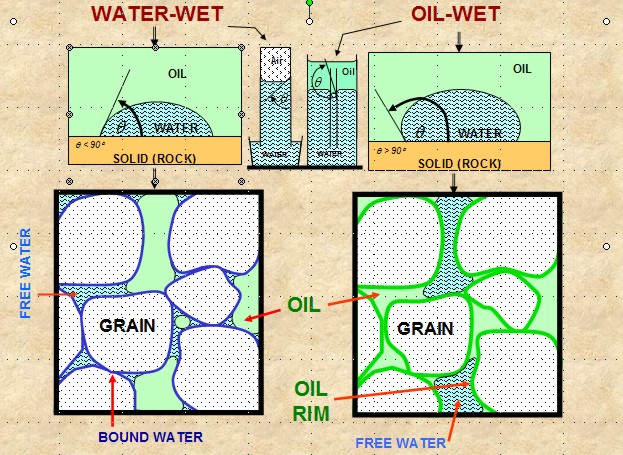
Comparison of water wet and
oil wet rocks
Wettability is
classified by its
variations;
Strongly oil or water wetting.
Neutral wettability – no preferential wettability
to either water
or oil in the pores.
Fractional wettability – reservoir that has local
areas that are
strongly oil-wet,
whereas most
of the
reservoir is strongly
water-wet - occurs where
reservoir rock has
variable
mineral
composition and surface
chemistry.
Mixed wettability – smaller pores are water wet and filled
with water, whereas
larger pores are oil wet
and filled with oil.
Residual oil saturation
is low - occurs where
oil with polar organic
compounds
invades a
water-wet rock saturated
with brine.
Wettability varies with
surface roughness, so
the wettability of a
rock will vary with
grain shape, size, and
rounding.
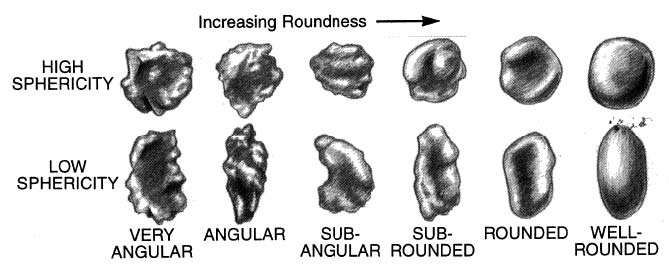
Roughness or angularity
of grains affects
wettability.
The current measuring
method uses a modern
contact angle goniometer
and is called the static
sessile drop method. The
contact angle goniometer
is an optical subsystem
which capture the
profile of a pure liquid
on a solid substrate.
The angle formed between
the liquid/solid
interface and the
liquid/vapor interface
is the contact angle.
Older systems used a
microscope optical
system with a back
light.
Current-generation
systems employ high
resolution cameras and
software to capture and
analyze the contact
angle.
The dynamic sessile drop
method is similar to the
static sessile drop but
requires the drop to be
modified. A common type
of dynamic sessile drop
study determines the
largest contact angle
possible without
increasing its
solid/liquid interfacial
area by adding volume
dynamically. This
maximum angle is the
advancing angle. Volume
is removed to produce
the smallest possible
angle, the receding
angle. The difference
between the advancing
and receding angle is
the contact angle
hysteresis.
 IMBIBITION and DRAINAGE
IMBIBITION and DRAINAGE
Imbibition is a
fluid flow process in which the
saturation of the wetting phase
increases and the nonwetting
phase saturation decreases.
(e.g., waterflood of an oil
reservoir that is water-wet).
Mobility of wetting phase
increases as wetting phase
saturation increases. Mobility
is the fraction of total flow
capacity for a particular phase
If a
water-wet rock saturated
with oil is
placed in
water, it will imbibe
water into the smallest pores,
displacing oil. If
an oil-wet rock
saturated with water is
placed in
oil, it will imbibe oil
into the smallest
pores, displacing
water.
Drainage
is a
fluid
flow
process
in which
the
saturation
of the
nonwetting
phase
increases.
Mobility
of
nonwetting
fluid
phase
increases
as
nonwetting
phase
saturation
increases
e.g.,
waterflood
of an
oil
reservoir
that is
oil wet
Gas
injection
in an
oil or
water
wet
reservoir. Pressure
maintenance
or gas
cycling
by gas
injection
in a
retrograde
condensate
reservoir.
A
water-wet
reservoir
that
accumulation
of oil
or gas
in a trap
does so
by
drainage.
Primary and waterflood oil recovery is affected by the wettability of the system. A water-wet system will exhibit greater primary oil recovery.
|

